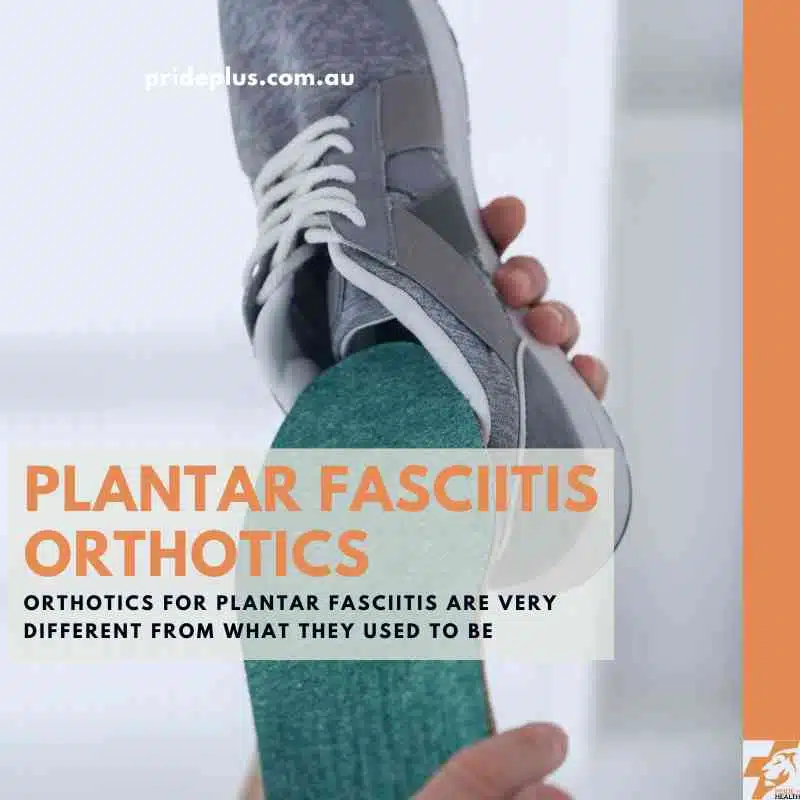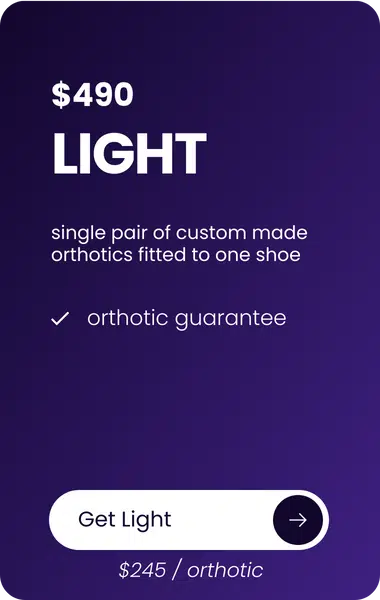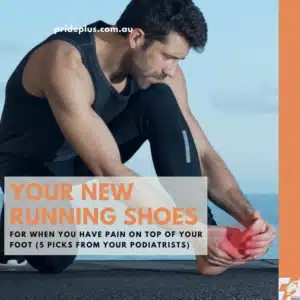For years and years, we’ve gotten orthotics for plantar fasciitis all wrong.
Historically, if you were looking for orthotics for your plantar fasciitis you had two options. The first was to grab a soft pair of insoles from the chemist, and the second was to see your podiatrist (or orthotist) for a hard pair made from rigid plastic.
Soft flexible bits of foam vs. hard pieces of plastic.
With two completely different types of orthotics for plantar fasciitis being offered, it’s no wonder that many of us didn’t overcome our heel pain and feel better.
And the cost of getting orthotics for plantar fasciitis so wrong is enormous:
- Wasted dollars on trial and error of arch supports that didn’t work.
- Time lost to pain and injury (missed games, runs and fun with the family).
- And lost trust.
Us podiatrists have a lot to answer for losing the trust of so many people who placed their faith in us to get a pair of orthotics for their heel pain which didn’t work.

Turns out, we got orthotics for plantar fasciitis completely wrong.
You don’t have plantar fasciitis because of poor shock absorption or poor foot shape, despite what outdated blogs may say.
You have plantar fasciitis because your plantar fascia is being overworked, simple as that. (Well, it’s a bit more complicated but let’s K.I.S.S). Soft insoles that aim to give you shock absorption but only provided comfort, not pain relief aren’t going to fix your problem. And rock hard orthotics that bend your foot into a new posture aren’t either. You need to take the overload, the excess strain on your plantar fascia away to get relief.
So what kind of orthotics for plantar fasciitis do that?
Orthotics for plantar fasciitis that optimise load
For success, your orthotics need to decrease the load on your plantar fascia and do it comfortably so you’ll want to wear them.
To do this podiatrists developed and implemented a new model of orthotic prescription. A model where your comfort is as paramount as the physics of human movement. We went back to basics, we identified what kinds of stress are being placed on your plantar fascia and then how we can reduce it.
We’ve also improved how we take an impression of your foot too.
For comfort, you must get an accurate 3D representation of your foot and for too long plaster moulds didn’t cut it. While setting and during transport, the plaster would bend and break. Now, in a matter of seconds, an accurate 3D laser scanned impression can be taken of your foot for your orthotic to be designed around.
And yet, sometimes we still get it wrong.
Unfortunately, some podiatrists are stuck in the past.
Not a week goes by without a new client coming in for a second opinion of their orthotics for plantar fasciitis that they’ve received elsewhere which are not working or are too uncomfortable to wear.
And we’re not immune from error ourselves too.
During our orthotic prescription process, we are working out how much we can push on your foot to decrease the load on your plantar fascia. We need to work out where on our foot, and how hard we can (and need) to apply a force.
Too much force and you’re stuck in the past with uncomfortable orthotics that don’t get worn. Too little force and you’ve got an expensive pair of soft innersoles again.
While these errors are rare at PridePlus Health, we’ll stand by you with our orthotic guarantee so that you’re not left holding the bag (of orthotics) without getting success. And if you’ve had a poor outcome elsewhere we’ll work with you to achieve your goals and we’ll offer your our orthotic guarantee for any devices you get from us.
Before you go…
When you have a complex overuse injury like plantar fasciitis you need to ensure you’re addressing all the factors that have led to your pain developing.
That means building capacity as you rehabilitate your overloaded fascia with the right exercises for plantar fasciitis. You can also increase your healing with shockwave therapy for plantar fasciitis. And getting the right shoes for your heel pain goes a long way in keeping your plantar fasciitis from returning.
Need orthotics for plantar fasciitis?
If you’re struggling with sore heels or have had a poor outcome with your orthotics in the past we’re here to help.
Book online (or give us a call) and our podiatrists will assess, support and if need be, prescribe you a pair of orthotics for your feet.
- Melbourne CBD Podiatry
- Pascoe Vale Podiatry
- Emerald Podiatry
About the author

Melbourne podiatrist Tim Mulholland learned about hard orthotics the hard way. Back when studying podiatry at La Trobe University (well before he started teaching there) his first pair of orthotics were thick, hard and downright impossible to wear for more than 5 minutes.
It was only by staying current with the research and clinical practice of orthotic therapy that he (and podiatrists like him) have come to appreciate the reasons why some orthotics for plantar fasciitis work and others don’t.
FAQ
A quick whip through the questions we often get asking in clinic out orthotics for plantar fasciitis.
Will custom made orthotics fix my plantar fasciitis?
Custom foot orthotics are fantastic at addressing the biomechanical factors contributing to overloading of the plantar fascia and subsequent plantar fasciitis.
However, we’re not just about optimising load by reducing compressive or tensile forces. As podiatrists we are also in the business of increasing capacity. Your custom orthotics will work best when housed in a pair of stable shoes, but they’ll also be perfectly complemented by a carefully constructed home exercise program.
These tailored exercises are designed to strengthen the surrounding structures that help stabilise and support the foot and arch, so the plantar fascia is assisted in its role.
The best ‘fix’ for your plantar fasciitis is likely to consist of a combination of therapies, including custom foot orthotics, a home exercise program and good footwear!
Will off-the-shelf orthotics fix my plantar fasciitis?
You’re bound to experience some pain relief when you slip these into your shoes. Those heavenly few steps that mimic the euphoria of crawling into bed after a long day of work.
However, as we now know, it is unlikely that an off-the-shelf device will adequately address the underlying biomechanical components contributing to your injury. As such, if you’re seeking long-term pain relief and fundamental improvements to stability and strength, a visit to your podiatrist is certainly warranted!
Do you need orthotic inserts?
Orthotic inserts able to reduce the load on over worked tissues or parts of your body. If you’re sore in your feet, ankle or legs then there is a good chance that an orthotic (when prescribed correctly) can reduce your pain.
So do you need orthotic inserts?
Well, if you’re in pain and you’d like to reduce your symptoms then an orthotic can be an effective part of your treatment plan.
How to shop for the best insoles for plantar fasciitis?
Let’s ask this question a little differently. How do you shop for your prescription medications?
We don’t shop for medications, they’re complex and have so many different actions, interactions and contraindications.
If we “bought” the wrong medicine we could become very ill or worse. Well, when it comes to shopping for the best insoles for plantar fasciitis, the risks aren’t quite as severe as taking the wrong medicine, but the principles are the same.
The right orthotic for you will be comfortable and help you achieve your goals. The wrong orthotic won’t. At best you’ll have wasted your money, at worst your pain or another injury can occur.
So avoid shopping for an insole or orthotic for your plantar fasciitis. Head to your expert podiatrist and have an assessment and an orthotic prescribed that is right for your needs. We guarantee our results so you don’t have to take the risk of your foot orthoses not helping.
Do arch supports make plantar fasciitis worse?
The wrong arch supports can make plantar fasciitis worse.
This is because plantar fasciitis is caused by overworking your plantar fascia. Some people suffer with an overworked plantar fascia because of too much compression in their fascia from a movement known as pronation. These people are more likely to have a flat foot. Others can have the same pain and the same injury from too much compression from the opposite movement (supination). On standing these are your more high arched feet.
Both high arched and those of us with a flat foot can suffer from plantar heel pain and if your shoe inserts aren’t spot on for your feet they can make your plantar fasciitis worse.
Can custom orthotics cure plantar fasciitis?
As plantar fasciitis is not really a disease, more of an injury it’s hard to say that we are ever able to cure plantar fasciitis.
Can you cure a broken arm? Not really.
But you can heal your broken arm in the same way you can heal your plantar fasciitis.
Custom orthotics can play an integral role in healing plantar fasciitis as they can be prescribed to reduce the stress and strain on your plantar fascia to allow healing to occur.
They work best when combined with a program to build up strength and capacity in the plantar fascia, foot muscles and calf muscles. These exercises are crucial to speed up the healing process of plantar fasciitis to help you overcome your foot pain.
Do orthotics really help plantar fasciitis?
Orthotics help plantar fasciitis.
Once you have a clear diagnosis of plantar fasciitis and your podiatrist has identified why (not just the what) is happening you’ll be prepared to get a pair of orthotics to help you overcome your pain and achieve your goals.
Combining your foot orthotics with a plan that addresses all your risk factors leads to the best results. This includes wearing supportive shoes (the right shoe size), addressing your foot function or foot mechanics, and working with your physical therapy team.
How to diagnose plantar fasciitis?
A clinical diagnosis from your expert podiatrist is the best way to diagnose plantar fasciitis. As there are many different causes of plantar heel pain your podiatrist will be able to take you through a thorough clinical examination to determine your diagnosis.
From there you and you podiatrist can come up with a plan to take your plantar aponeurosis from it’s sore and overworked state back into it’s healthy functioning zone.
As a starting place you can complete our free online plantar heel pain test to get an idea if your pain is chronic plantar fasciitis or something else.
Why seeing your physiotherapist will help speed up your plantar fasciitis recovery?
Your physiotherapist can be one of the most helpful people in your quest to resolve your heel pain. As with many common foot complaints plantar fasciitis requires some active capacity building exercises.
Physiotherapists are excellent at determining the exact exercises you need to do, and the dosage of how much, how often to get your tissues strong. This is particularly important for those who have chronic plantar fasciitis where steroid injections provide no lasting relief.







